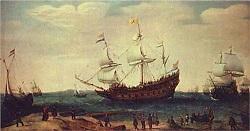
Published date
25 March 1647
Since Bartholomew Dias managed to circumnavigate the Cape in 1488 in an attempt to find a sea route to the spice lands of East Asia, numerous Dutch ships, called Indiamen, dared the demanding route to East Asia in their relatively ill-equipped vessels. They used navigational instruments that could not meet the challenge of the oceans. The area immediately surrounding the Cape was particularly treacherous. Officially known as the Cape of Good Hope or Cabo do Bona Esperana, this route was soon renamed the Cape of Storms as countless Indiamen ran aground or suffered shipwreck while negotiating the route around the Cape peninsula. They were generally hoping to barter fresh meat and water from the indigenous people who lived on the peninsula.
On 25 March 1647 the Dutch Indiaman, the Nieuwe Haerlem, one of a fleet of Indiamen, was wrecked in a storm in Table Bay. At first this shipwreck seemed much less dramatic than the countless ships that had run aground before it: no crewperson was killed and the invaluable cargo could be salvaged. However, this shipwreck was destined to change the course of history, leading to the creation of a new state on the southern part of the African continent.
The captain of the Nieuwe Haerlem instructed a junior merchant, Leendert Janszen, to remain behind with approximately 60 crewmen to look after the cargo that could not be loaded onto the remaining vessels of the fleet that was returning to Holland.
Janszen built a temporary fortification for the crew and cargo. He waited for about a year before he and his crew were taken on board by the homeward-bound fleet under Wollebrandt Geleynsz de Jongh. During the waiting period Janszen and his crew grew vegetables, bartered fresh meat from the Peninsular Khoi people and fished. Upon his return to Holland Jansz and a fellow officer, Nicolaas Proot were required by the Dutch East India Company (VOC) Directorate to compile a report on the feasibility of the Cape for a refreshment station, an idea that had been mooted decades earlier.
Janszen and Proot compiled the report and handed it to the Directorate in 1649 as an official document called a Remonstrantie. In this report Janszen recommended the suitability of the Cape for a refreshment state. He pointed out its strategic location, the fertility of the land, the abundance of fish and most importantly, the lack of animosity towards strangers from the indigenous people. Jan van Riebeeck, who was on the fleet that repatriated Janszen and his crew, was asked to comment on the Remonstrantie. He supported Janszen and Proot in all aspects.
The Directorate of the VOC approved the Remonstrantie in 1650 and a year later, in 1651, the Amsterdam chamber of the VOC sent Van Riebeeck to establish the refreshment station at the Cape. Van Riebeeck landed in Table Bay in 1652 to execute this project.
The Remonstrantie, which is housed in the Cape Town Archives Repository, is regarded as the oldest written public - that is governmental or official-archival record of the region that was to become known as the South African state. Van Riebeeck brought it along with a set of instructions for setting up the refreshment station. On a final note it has to be said that, far from being developed as merely a refreshment station, the Cape became the gateway to the colonisation of the entire region as far north as the Orange and Limpopo Rivers.
References
EWH, Dutch in South Africa, from Epic World History, [online], Available at epicworldhistory.blogspot.com [Accessed: 24 March 2014]|Blaauberg Online, Shipwrecks of the Blaauberg coastline, from Blaauberg Online, Available at www.blaauwberg.net [Accessed: 24 March 2014]